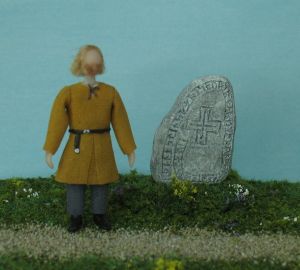This is more of a light-hearted facts and links page; only some of the photos show miniatures. I originally wrote this page as a treat for my "table mates" at an online miniature convention.
Click on the thumbnails for bigger pics. Please note that in the text there are also some links to nice photos (or additional information) on other sites - for copyright reasons I haven't included the actual photos on this page.
Welcome!

You're all welcome to take a trip to another time, to meet some international travellers living a long time ago - the Vikings, my possible ancestors. So please step into the time machine everyone. Those who are away will be able to catch up with us and meet us there - no matter when you choose to travel, just set the arrival time to noon on October 24, 905 A.D. and we'll arrive the same time. Oh, and enter the goal as "Birka". The GPS will sort out how to get you there.
Birka was a town and trading center on a small island in a lake, about 20 km (15 miles) west of Stockholm, Sweden. The site was in use for a couple of centuries, until a waterway that was essential to the trade was getting too shallow to use, due to the post-glacial rebound. On the map of present-day Sweden to the right, it's in the center of the red circle; the island itself is way too small to show up on a map this scale.
I see you're all seated in the time machime so now I press the button and off we go. The trip in time will take a few minutes so I'll be sharing some general Viking information during the
"flight".
Who were the Vikings?
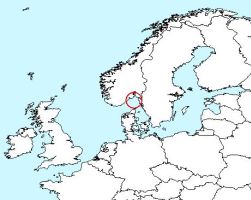 The word Viking means "fjord (or bay) people". There are different
theories to how they got their name - either because it all started with people from "Viken" ("the bay" - marked with a red circle in the map to the right), or because the Vikings in
their speedy longships would hide in a fjord (vik) and then launch surprise attacks on passing ships. Strictly speaking, only the people who went on raids were called Vikings. They were
probably part time farmers, but there was a large population of regular farmers too. Going on raids was practical only to those who lived close to the sea.
The word Viking means "fjord (or bay) people". There are different
theories to how they got their name - either because it all started with people from "Viken" ("the bay" - marked with a red circle in the map to the right), or because the Vikings in
their speedy longships would hide in a fjord (vik) and then launch surprise attacks on passing ships. Strictly speaking, only the people who went on raids were called Vikings. They were
probably part time farmers, but there was a large population of regular farmers too. Going on raids was practical only to those who lived close to the sea.
The Viking age
The Viking age is usually defined as the period 793 to 1066 - beginning with the earliest recorded Viking attack, which hit the monastery in Lindisfarne, England. It ends with the death of king Harald Hårdråde of Norway in a battle against king Harold Godwinson of England, which put an end to the large invasions. But there's more to Vikings than just plundering England!
Where the Vikings went on their raids
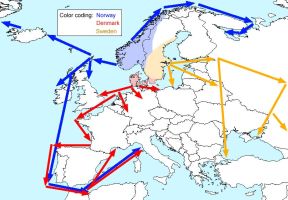 Vikings from all over Scandinavia probably participated in plunderings at
some point, but there seems to have been certain trends in where they went and what they did, depending on where they lived. Check out the map to the right, with color codings for where Danes,
Norse and Swedes lived, and where they went on their, erhm, trips.
Vikings from all over Scandinavia probably participated in plunderings at
some point, but there seems to have been certain trends in where they went and what they did, depending on where they lived. Check out the map to the right, with color codings for where Danes,
Norse and Swedes lived, and where they went on their, erhm, trips.
It's really anachronistic to talk about Sweden, Norway and Denmark as countries this far back (the countries were still being formed, and the borders were noticably different from today), but it does make it easier to follow. So, in short:
- There were Norwegian settlements on Shetland, Ireland, Iceland, Greenland and on the west coast of England.
- The Danes founded a Viking kingdom in England that lasted for two centuries (the Danelaw).
- There were also Viking trading points in England like Jøfurvik (a.k.a. Jorvik or York).
- The Vikings in eastern Sweden were often traders travelling east instead of west, on the rivers of Russia.
Blending in
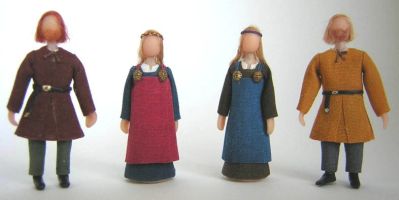
We're already halfway there, so there's a few things I need to point out.
Of course we'll draw way too much attention if walking around
in 21st century clothes in a Viking age town. So, the moment you step out of the time machine they'll automatically transform into something like this.
(1:48 scale vikings by me.)
At that point, you'll also notice that all of a sudden you've started talking 10th century English. Don't worry, you'll soon get used to it, and as Old English is much closer related to Old
Norse (the language spoken in the Scandinavian or Nordic region, with regional variations of course) than current-day English and Swedish are to each other, you'll find it tolerably easy to
understand the natives.
Traders or plunderers
Back to the info on Viking history... I'll be focusing on the Viking age people in eastern Sweden, as that's where we're going.
I mentioned that the Swedes tended to go east rather than west. The area that is now Southern Sweden long belonged to Denmark, so Vikings from eastern Sweden would literally have had to pass through Denmark to get to the North Sea. Maybe the Danes found it lucrative to raid Swedish ships that wanted to pass through, or perhaps the Swedes preferred going east simply because Russia was much closer than England, and they didn't have to compete with the Danes there. The Vikings travelling east were known as Varangians or Variags, or Rus (hence Russia). They built settlements near the Russian rivers, and their trade routes stretched all the way to the Byzantine Empire. They formed alliances with locals leaders, through marriages and other means. Maybe to benefit their trading (or plundering?).
Mercenaries
In the 9th century, some of them were employed as mercenaries by the Byzantine Emperor, in his Varangian Guard. In between fighting those guys were guilty of some runic graffiti. A couple of
inscriptions are known and can still to be seen in the Mediterranean area. For instance, in the late 18th century, a Swedish diplomat noticed a runic inscription on the so-called Pireaus Lion in Venice.
It had originally been placed in the Piraeus harbor of Athens, and was much later taken to Venice as a war trophy.
The inscription is heavily eroded but is belived to say: "Hakon, together with Ulf, with Asmund, and with Orn, conquered this port. These men and Harold the Tall imposed large fines, on account of the revolt of the Greek people.
Dalk has been detained in distant lands. Egil was waging war, together with Ragnar, in Romania and Armenia." According to the inscription on the lion's other shoulder, it was Harold the
Tall who ordered these engravings, against the wishes of the defeated Greeks. He was then working as a mercenary for the Byzantine emperor.
Rune stones
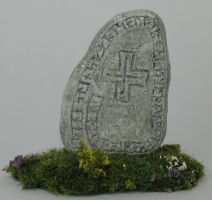
There are around 2500 rune stones in Sweden. Most are concentrated roughly around the area where Stockholm is today. There are only a few hundered rune stones in Norway and Denmark so it's mostly a Swedish thing. Many of them were set up as memorials of deceased relatives, from the late 900s to the early 1100s. Most rune stones just say who let raise the stone, who carved the runes, and in whose memory, but some
tell e.g. that a person has travelled to Greece, or died on a pilgrimage to Jerusalem. Most rune stones are Christian monuments, often carved with a cross and ending in a prayer for the
deceased's soul. (The first known missionary had come to the city of Birka in 829.) Other stones e.g. boast of the building of a road embankment. They're the earliest source of written
information in Sweden. Vikings carved runes in e.g. bits of wood or animal bones too, but very few of these have survived. Rune carving started as early as AD 200 but at that point they seem to
have been used as magic signs for protection.
(1:48 scale runestone by by me, in the collection of Pam Scott.)
Just one single rune stone has the word Viking in its inscription. It's in the area where I grew up, about 30 km (20 miles) northwest of Stockholm, and bordering on lake Mälaren in which Birka is situated.
The stone's inscription says "Ginlög, Holmger's daughter, sister of Sigröd and Gaut and their siblings, she had this road embankment made and this stone erected after Assur,
her husband, son of Earl Hakon. He was a Viking vordr along with Geitir. God help his spirit and soul." Unfortunately, the word vordr has multiple meanings like guarder or
ruler, so it isn't clear whether he was guarding against Vikings, or if he was a Viking chieftain. You can see the stone here.
Arriving in Birka
We've now arrived at our destination, Birka. Please step out, one at a time, there's no need to hurry. Remember, if we run out of time today we can always come back yesterday!
We're now standing on Björkö ("Birch island"), a small island in lake Mälaren, right to the west of Stockholm if any of you brought your modern maps. This is the city of Birka,
founded around AD 750, and Sweden's first city. Less than 1000 people live here; there are mainly craftsmen, traders and guards. Mälaren is connected to the Baltic Sea through a few
straights, but the land rise is making the preferred route more and more shallow so it's increasingly harder to navigate. About 50 years from now it will be so bad that Birka is abandoned after
only about 200 years, and commerce moves to a newly founded city at a better location. But the memory of there being a city here will stay alive, and in the 1680s the director of the board of
national antiquities will be the first archaeologist to dig here. There will be many more digs in the 19th and 20th century, and at the Birka museum there'll be 1:15 scale models of how part of
Birka may have looked, based on the excavations in the 1990s. Of course there's also a website if you'd like to read more about
this Swedish world heritage later.
Please behave yourselves, ladies!
Okay, could everyone please stop flirting with the Viking warrior, so we can get going? Did you notice
that he didn't have a horned helmet? No, I thought not... Anyway, Vikings with horned helmets didn't appear until late in the 19th century. When the stage costumes for Wagner's Nibelungen Ring
were designed the helmets were given with all kinds of fancy embellishments that would look well on stage, some were horned and others winged. The opera got lots of publicity of course,
probably with pics and all. After that the horns started turned up in German and English illustrated children's books about Vikings, and suddenly they were everywhere.
The town and houses
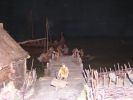
(Photos of models in the museum at Birka - not my creations!)
As you can see, the town plan is very simple. The streets stretch from the landing
stages at the shore and straight inland. Smaller lanes connect the streets with each other. The streets are nicely paved with cleft logs, but you might want to watch out for the pig
droppings.
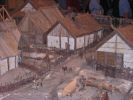 The dwelling houses measure roughly 8×5 meters (26×16 ft). They are built of
horizontal beams slotted into uprights and have plank floors. The workshops are built of wattle-and-daub and have clay floors, to reduce the risk of fire. The roofs are covered with sod, or
wood shingles, or planks or thin logs securing a waterproof layer of birch bark.
The dwelling houses measure roughly 8×5 meters (26×16 ft). They are built of
horizontal beams slotted into uprights and have plank floors. The workshops are built of wattle-and-daub and have clay floors, to reduce the risk of fire. The roofs are covered with sod, or
wood shingles, or planks or thin logs securing a waterproof layer of birch bark.
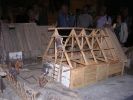
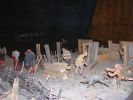 Here, houses are being built. The building techniques and house sizes vary between different areas, especially depending on the materials available locally. But the vast majority of the Viking-age people in Sweden lived in
longhouses on farms in the countryside, probably built using similar techniques and supplies.
Here, houses are being built. The building techniques and house sizes vary between different areas, especially depending on the materials available locally. But the vast majority of the Viking-age people in Sweden lived in
longhouses on farms in the countryside, probably built using similar techniques and supplies.
The largest house on the island would the warriors' house in the garrison, which is 19 meters (62 ft) long. But we won't get to see it at this trip.
A royal estate
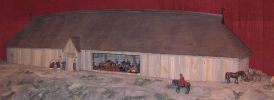
(Photos of models in the museum at Birka - not my creations!)
On the island of Adelsö, close to Björkö and Birka, lies
Hovgården, a Viking age royal estate with a great hall (you can read about it on the webpage about Birka mentioned above). Isn't it huge!
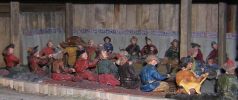 Thanks to our X-ray vision we can look straight through the wall and see what
they're up to. The king is appearently holding a feast right now.
Thanks to our X-ray vision we can look straight through the wall and see what
they're up to. The king is appearently holding a feast right now.
Food
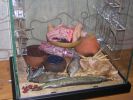
BTW, are any of you getting hungry yet? Here's a museum exhibit of an assortment of food to make your mouth water (or not - it isn't cooked yet).
Furniture
I suppose you'd like to visit one of the homes (my Viking roombox) too?
Or check out this illustration.
As you can see, there is very little furniture really.
There are built-in benches along most of the walls, to sit, work, or sleep on.
They're often filled with dirt which seems to help insulating the house - at least they shouldn't have problems with drafty floors!
There would probably also be an upright loom, used for weaving fabric for clothes, or making beautiful tapestries. Archaeological
evidence shows that many of the fabrics produced equalled or surpassed the best qualities of linen or woolen fabrics available today.
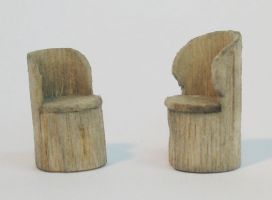
A wealthier home may have a chair made from a hollowed-out log, as seen to the right. No such chairs have been found in excavations (I bet they became firewood when they weren't useable anymore!), but archaeologists know they existed because they've found some miniature chairs made of silver, used as charms on bracelets or necklaces! Here's one of them (the ruler is graded in centimeters; the scale of the chair is about 1:48). Rich people might also have separate beds instead of sleeping on the standard benches. This bed was found in a Viking boat grave, in Oseberg, and another bed was found in a grave in Gokstad (both in Norway).
Crafts
Among the inhabitants of Birka there are blacksmiths, and various craftsmen who cast bronze jewellery, make simple ceramics, tan hides, make combs and other bone objects, build boats, or make glass beads.
A Viking age tool chest full of tools was found in 1936, in a bog at the island of Gotland in the Baltic Sea. That bog was a lake during the Viking age, so maybe the carpenter had gone through the ice during a winter time travel across the lake. Let's hope he could save himself by letting go of the chest. Here's a photo of the chest and tools. As you can see on a page about Viking age woodwork, many of the tools look very much like modern-day hand tools.
Trade
Look, there's a wealthy trader or other upper-class man. His clothes are very much influenced by the Oriental fashions that he would've seen as a trader or mercenary abroad. He must've made a lot of money, as his jacket is embellished with imported silk ribbon, and his trousers required several yards of fabric. His clothes are based on Birka grave finds in combination with some items found in Denmark and York. Fabric perishes quickly in the Birka soil, and is often preserved only where it's been chemically protected by lying next to brooches and other metal objects.
Thank you for your attention!
Well, that concludes today's tour. Now you can run around until midnight and do what you please, but don't forget that my Time Machine home leaves at midnight precisely. Those who don't turn up on time will be stuck here for life... And try to stay out of the warriors' house, okay? We've got a reputation to uphold.
